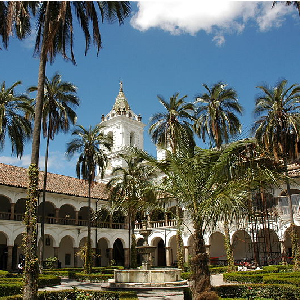Samara State Aerospace University (SSAU) opens the first Cultural Centre of “Pushkin Institute” in Latin America in the capital of Ecuador Quito.
Samara State Aerospace University is one of the 20 Russian universities, which participates in the program of the Government of the Russian Federation to promote the Russian language, culture and education in foreign countries in cooperation with Pushkin State Russian Language Institute from 2013. The promotion is carried out through the foundation of cultural centres of the “Pushkin Institute”, which are analogous to the Spanish “Instituto Cervantes” and Chinese “Confucius Institute”.
The Centre of “Pushkin Institute” will be one of the main oasises of Russian culture in Latin America. Its foundation was possible by virtue of the SSAU interaction with Latin American and Russian Association of Higher Education (ALAR). The new Russian Cultural Centre in Quito opens based on the Latin American and Russian Fund, which is a representative of ALAR in Ecuador. Over time, these centres will be opened in other Latin American countries, where the association has its offices: in Brazil, Mexico, Peru, Bolivia, Colombia.
For Samara Aerospace University participation in such a project is an opportunity not only to promote the deepening of cultural cooperation with Latin American countries, but also a chance to expand its educational base due to the students from this macro-region.
“ALAR promises to provide these centres with a good flow of students interested in studying the Russian language and further entering Samara State Aerospace University. We will work as follows: organize the first stage of the Russian language teaching in Latin American countries. This approach is simpler and cheaper for the local residents, and it is advantageous for us, as it expands the circle of those applicants who could come to study in Samara”- said Sergey Tits, Head of SSAU International Department.
The representatives of Russian expatriate communities, embassies, as well Russian embassy schools will teach in the new Russian cultural centres in Latin America. The education system will be structured in such manner as to identify the best ones on the one hand, and to prepare students who live in the Southern hemisphere of the Earth adequately to the peculiarities of life and study in Samara on the other hand.
“We shall be able to monitor the progress of the young people with the help of distance control tests, we shall see the dynamics and we shall tell them whereat to pay attention in the learning process. Besides, it will be possible to add to the program, the Russian language study, conversance with the culture of Russia, as well as the courses in mathematics, physics and computer science. This work will allow us to gather good applicants, to promote the university name. These applicants will clearly understand where they go, they will get acquainted in absentia with Samara, Aerospace University and our specialties. We shall be able to choose the best applicants”, "- said Evgeniy Izzheurov, Dean of SSAU Faculty of Basic Training and Fundamental Sciences, curator of the project “Pushkin Institute”.
In recent years Latin American countries have an increased focus on establishment of high-tech industry and space exploration at the domestic level. For example, Brazil has almost reconstructed its space launcher complex Alcantara, which was destroyed due to explosion of the carrier rocket VLS-1, developed by the Brazilian Space Agency, and for the last few years the most reliable spacercraft in the world - Russian carrier rockets “Soyuz” produced by the Rocket and Space Centre “Progress” (Samara), are being launched from the space launcher complex Kourou (French Guiana).
The International Latin American Applied Scientific Conference on Space Research will be held in Ecuador in 2016. Within its framework a creativity competition will be organized for pupils of Latin America, and also the Forum for the graduates of Kuybyshev Aviation Institute (currently SSAU), who now live in Latin America, will be held. Therefore, obviously there will not be any lack of volunteers willing to study in Samara State Aerospace University.
For reference
International activities of SSAU began in 1990, when travel restrictions for the university specialists and acceptance abridgement for foreign students were lifted. Students from Bangladesh, Bulgaria, India, Iran, Cameroon, Kenya, China, Costa Rica, Lebanon, Mauritius, Madagascar, Morocco, Nigeria, Oman, Pakistan, Peru, Senegal Sri Lanka and other countries studied before and study now at the University on the assignment of the Ministry of Education of the Russian Federation and on a contract basis.
SSAU foreign partners are: French University of Aviation and Astronautics in Toulouse, Beijing and Shanghai University, the University of Bath, American Purdue University. SSAU works within city partnership of Samara and Stuttgart (Germany), Samara Region and the provinces of Hainan and Shenzhen (China), North Rhine-Westphalia area (Germany). The university has direct scientific, technical and educational links with sister institutions. Over the years, comprehensive agreements have been concluded with five universities of People's Republic of China, Bradley University (USA), State University of Aircraft Design Engineers ENSICA (France), Institute of Technology Carlow (Ireland), Lulea University (Switzerland). A double diploma program has been successfully implemented together with Harbin Institute of Technology (China) since 2010.
According to the “road map” of development of Samara State Aerospace University, the number of foreign students in SSAU should reach 13.5% of the total number of students by 2020.
 RU
RU  EN
EN  CN
CN  ES
ES 